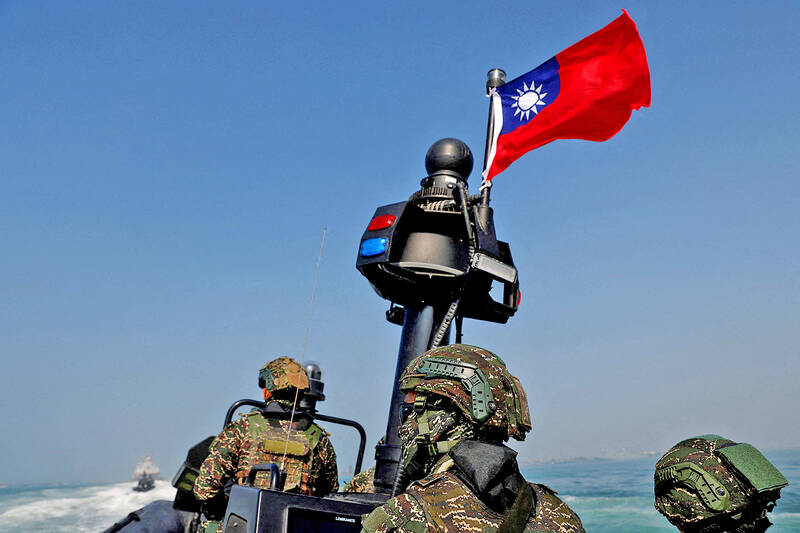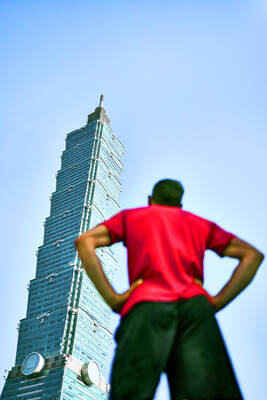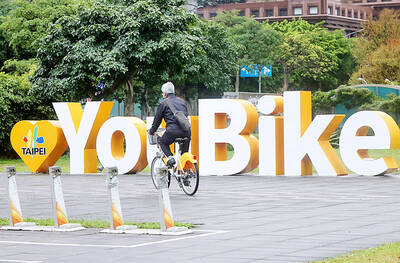President-elect William Lai’s (賴清德) best strategy to stop China from seizing Taiwan would likely be to bolster an agile defensive “porcupine” approach by spending more on missiles and drones, analysts said.
Lessons learned from Russia’s war in Ukraine about how rapidly developing drones can outfox traditional heavy weaponry show that Lai would boost Taiwan’s production of modern military technology after he takes over as president tomorrow.
“Taiwan is taking the Chinese military threat more seriously,” RAND Corporation Taiwan Policy Initiative director Raymond Kuo said.

Photo: Carlos Garcia Rawlins, Reuters
“It has ramped up its production of anti-ship missiles, tested new anti-air missiles, and is on track to manufacture several thousand military drones,” he said.
“I would expect those efforts to continue [under Lai] alongside purchases of US equipment and development of large platforms like the indigenous submarine.”
Washington switched diplomatic recognition from Taipei to Beijing in 1979, but it has remained Taiwan’s most important partner and biggest arms supplier.
Beijing maintains a near-daily presence of fighter jets, drones and naval ships around Taiwan in what experts call “gray zone” actions — tactics that fall short of an act of war.
US Secretary of State Antony Blinken asked Beijing during a visit to China last month to avoid “provocative” measures during Lai’s inauguration tomorrow.
Taiwan authorities have detected dozens of Chinese aircraft near the nation in recent days. Beijing, which calls Lai a “dangerous separatist,” is expected to intensify military pressure in the coming years, underscoring the security challenges facing his administration.
“This reality means that a key measure of success of the Lai administration will be how far he can push forward the necessary reforms to improve Taiwan’s ability to defend itself and deter Chinese aggression,” International Crisis Group senior analyst Amanda Hsiao (蕭嫣然) said.
Washington approved a huge military aid package for Taipei last month in the face of an increasingly assertive China, including US$1.9 billion for replenishing its military equipment and training.
Another US$2 billion would be used for “foreign military financing” for countries in the region.
Taiwan is under pressure to increase its defence spending and adopt a “porcupine” strategy to deter an attack from China, National Chengchi University Taiwan Center for Security Studies Director Richard Hu (胡瑞舟) said.
“With lessons learned from the Russian-Ukraine war, the defence ministry will try to switch from buying expensive and heavy weapons systems to some light, agile and lethal arms and equipment, such as battle-tested UAVs (drones) and Javelin missiles,” Hu said.
Lai has appointed National Security Council chief Wellington Koo, a lawyer with no military rank, to head the defence ministry and oversee the transformation, but there has been pushback, Hsiao said.
“Not everyone in the relevant government agencies is convinced of this strategy,” Hsiao added.
Chinese military pressure on Taiwan escalated during Tsai’s presidency, with Beijing holding its largest military drills around the nation last year.
However, Taiwan has seen a shift in China’s actions in recent months. Aerial incursions have decreased, but the outlying island of Kinmen has seen a pick-up in regular patrols by the China Coast Guard and other vessels.
“China’s use of ‘gray zone’ tactics is shifting from military brinkmanship to more law enforcement,” political scientist Sung Wen-ti (宋文笛) said.
That might “involve more direct contact between civilian personnel from both sides and carry more complicated potential for political escalation.”
China’s goal of eventually seizing Taiwan remains the same, SOAS China Institute Director Steve Tsang (曾銳生) said.
“Taipei, the US and others concerned must use the time to work to pre-empt or deter a Chinese attack.”

US climber Alex Honnold is to attempt to scale Taipei 101 without a rope and harness in a live Netflix special on Jan. 24, the streaming platform announced on Wednesday. Accounting for the time difference, the two-hour broadcast of Honnold’s climb, called Skyscraper Live, is to air on Jan. 23 in the US, Netflix said in a statement. Honnold, 40, was the first person ever to free solo climb the 900m El Capitan rock formation in Yosemite National Park — a feat that was recorded and later made into the 2018 documentary film Free Solo. Netflix previewed Skyscraper Live in October, after videos

Starting on Jan. 1, YouBike riders must have insurance to use the service, and a six-month trial of NT$5 coupons under certain conditions would be implemented to balance bike shortages, a joint statement from transportation departments across Taipei, New Taipei City and Taoyuan announced yesterday. The rental bike system operator said that coupons would be offered to riders to rent bikes from full stations, for riders who take out an electric-assisted bike from a full station, and for riders who return a bike to an empty station. All riders with YouBike accounts are automatically eligible for the program, and each membership account

A classified Pentagon-produced, multiyear assessment — the Overmatch brief — highlighted unreported Chinese capabilities to destroy US military assets and identified US supply chain choke points, painting a disturbing picture of waning US military might, a New York Times editorial published on Monday said. US Secretary of Defense Pete Hegseth’s comments in November last year that “we lose every time” in Pentagon-conducted war games pitting the US against China further highlighted the uncertainty about the US’ capability to intervene in the event of a Chinese invasion of Taiwan. “It shows the Pentagon’s overreliance on expensive, vulnerable weapons as adversaries field cheap, technologically

NUMBERs IMBALANCE: More than 4 million Taiwanese have visited China this year, while only about half a million Chinese have visited here Beijing has yet to respond to Taiwan’s requests for negotiation over matters related to the recovery of cross-strait tourism, the Tourism Administration said yesterday. Taiwan’s tourism authority issued the statement after Chinese-language daily the China Times reported yesterday that the government’s policy of banning group tours to China does not stop Taiwanese from visiting the country. As of October, more than 4.2 million had traveled to China this year, exceeding last year. Beijing estimated the number of Taiwanese tourists in China could reach 4.5 million this year. By contrast, only 500,000 Chinese tourists are expected in Taiwan, the report said. The report